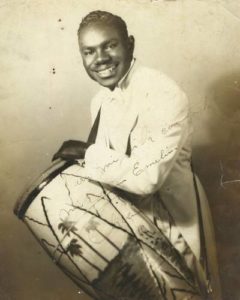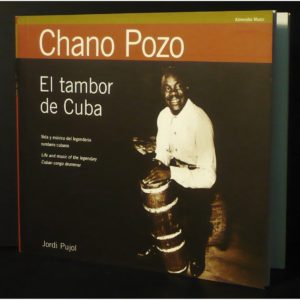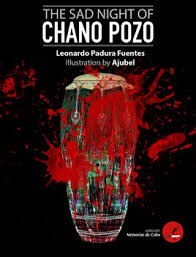 “CHANO” POZO, UNA LEYENDA CRIOLLA DE EXTRAORDINARIOS APORTES A LA RUMBA Y AL JAZZ.
“CHANO” POZO, UNA LEYENDA CRIOLLA DE EXTRAORDINARIOS APORTES A LA RUMBA Y AL JAZZ.
El paso del tiempo no ha podido borrar la trascendencia rítmica y musical del talentoso Luciano Pozo González, conocido profesionalmente como Chano Pozo, nacido el 7 de enero de 1915 en La Habana. Fue un percusionista, cantante, bailarín y compositor cubano de jazz. A pesar de vivir solo hasta los 33 años, jugó un papel importante en la fundación del jazz latino. Co-escribió algunas de las composiciones con sabor latino de Dizzy Gillespie, como “Manteca” y “Tin Tin Deo”, y fue el primer percusionista latino en la banda de Gillespie. Pozo fue y sera el excepcional orgullo como tamborero y compositor de Cuba y del mundo por muchos años.
Desde muy pequeño sintió la música muy cercana, bebió de ella en medio de las celebraciones que casi a diario se realizaban en la comunidad marginal de La Timba, muy cerca de la Loma de los Catalanes, cerca de donde está la hoy conocida como la Plaza de la Revolución. Allí creció, logrando emocionarlo e inspirarlo de forma permanente, hasta que aprendió a tocar en los solares, de manera espectacular y autodidacta, la tumbadora y el tambor llamado conga, sus preferidos, siendo calificado con toda justeza como El Tambor de Cuba.
Todos le profesaban gran cariño y admiración por su arte y maestría con el bongó, que formaba parte inseparable de él, y así transcurrió la infancia de Chano Pozo, la misma de los niños negros en aquellos años de la Cuba republicana.
Su sentido rítmico lo hizo ir más allá y se formó también como bailador, cantante y compositor, dejando en los primeros años juveniles su impronta en las comparsas de los carnavales capitalinos, a las que se vinculó con gran entusiasmo y entrega. De su autoría, todavía los cubanos tararean su conocida interpretación de “… siento un bombo, mamita me está llamando”, retomada después por otros reconocidos músicos.
https://youtu.be/sw0Da7ERvH0
Su vida fue muy corta, apenas 33 años, pero le bastaron para convertirse en un genio de la percusión y la composición, con un talento natural y espontáneo, siendo trascendente su contribución a la cultura musical cubana y al jazz, desbordando su cubanía en cualquier escenario.
Precisamente sus inicios se recuerdan en la emisora de radio RHC Cadena Azul, donde encontró el ámbito propicio para mostrar con libertad todas sus facultades, ingenio y destreza interpretativa. El son y la guaracha fueron géneros musicales cultivados por él no solo como fecundo creador, sino también como intérprete brillante de la tumbadora desde las filas de su Conjunto Azul.
Sus incursiones a partir de 1946 en la ciudad norteamericana de Nueva York lo convirtieron en un hito dentro del convulso y original panorama del jazz en Norteamérica, logrando la imbricación de los elementos afrocubanos con este género de la música que allí se hacía y ese fue básicamente su aporte a lo que luego se definiría como latin jazz o jazz afrocubano, a partir de su encuentro con el famoso trompetista Dizzi Gillespie y la integración a su banda, quien consideró a Chano Pozo como “el más grande tamborero que he oído en mi vida”.
En esa etapa brilló como uno de los músicos cubanos más extraordinarios, haciendo gala también del conocimiento profundo de las raíces africanas. Podía tocar seis tambores de congas al mismo tiempo y desarrollar una gran capacidad para la improvisación.
CHANO POZO, LEYENDA DE LA RUMBA Y EL JAZZ.
En apenas dos años revolucionó el jazz americano, aportó con amplitud al tejido rítmico del Afro Cuban Jazz e insertó plenamente el baile de su rumba sobre todo en una tonalidad muy rápida, llamada la jiribilla, y teniendo como compañero a su propio tambor, al cual hacia girar de manera vertiginosa, arrancando los aplausos incesantes del público.
Resulta impresionante la rica trayectoria musical que en tan poco tiempo desarrolló Chano. La lista de sus obras como compositor es extensa, así como la relación de sus grabaciones y reediciones de las obras, de su discografía como intérprete principal y músico de sesión, en un amplio recorrido de sus grabaciones en Cuba y los Estados Unidos. Baste recordar que fue el autor de unas 112 melodías, entre ellas la pieza clásica del jazz afrocubano Manteca. Supo enseñar a los percusionistas de jazz la ejecución de la polirritmia cubana, lo cual elevó su reconocimiento y fama.
Chano Pozo fue asesinado a tiros el 2 de diciembre de 1948 en El Rio Bar en 111th St y Lenox Avenue en Harlem. El Rio Bar ya no existe, incluso se ha eliminado el pequeño bloque triangular donde estaba ubicado. El asesino de Pozo era un corredor de apuestas local llamado Eusebio “Cabito” Muñoz. Pozo había acusado a Cabito de venderle marihuana de mala calidad y Cabito tomó represalias.
Pozo está enterrado en el cementerio de Colón, La Habana.
 CHANO POZO, A CUBAN LEGEND FOR HIS EXTRAORDINARY CONTRIBUTIONS TO THE RUMBA AND JAZZ.
CHANO POZO, A CUBAN LEGEND FOR HIS EXTRAORDINARY CONTRIBUTIONS TO THE RUMBA AND JAZZ.
The passage of time has not been able to erase the rhythmic and musical significance of the talented Luciano Pozo González, professionally known as Chano Pozo, born on January 7, 1915, in Havana. He was a Cuban percussionist, singer, dancer and jazz composer. Despite living alone until age 33, he played an important role in the foundation of Latin jazz. He co-wrote some of Dizzy Gillespie’s Latin-flavored compositions, such as “Manteca” and “Tin Tin Deo,” and was the first Latin percussionist in the Gillespie band. Pozo was and will be the exceptional pride as drummer and composer of Cuba and the world for many years.
From a very young age he felt the music very close, he drank from it in the midst of the celebrations that were held almost daily in the marginal community of La Timba, very close to the Loma de Los Catalanes, near where is now known as the Plaza of the Revolution. There he grew up, getting him excited and inspiring him permanently, until he learned to play on the lots, in a spectacular and self-taught way, the tumbadora and the drum called conga, his favorites, being qualified with all fairness as El Tambor de Cuba.
All professed great affection and admiration for his art and mastery with the bongó, which was an inseparable part of him, and thus passed the childhood of Chano Pozo, the same of black children in those years of Cuba Republicana.
His rhythmic sense made him go further and he also trained as a dancer, singer, and composer, leaving his imprint in the early years of the capitals of the carnivals of the capital, to which he linked with great enthusiasm and dedication. From its authorship, Cubans still hum their well-known interpretation of “… I feel a hype, mamita is calling me”, later resumed by other renowned musicians.
His life was very short, just 33 years, but it was enough to become a genius of percussion and composition, with a natural and spontaneous talent, his contribution to Cuban musical culture and jazz being transcendent, overflowing his Cubanness in any stage.
Precisely its beginnings are remembered on the radio station RHC Cadena Azul, where he found the right environment to freely display all his faculties, ingenuity, and interpretive skills. The son and the guaracha were musical genres cultivated by him not only as a fruitful creator but also as a brilliant interpreter of the tumbadora from the ranks of his Blue Ensemble.
His incursions from 1946 in the North American city of New York made it a milestone in the turbulence and original panorama of jazz in North America, achieving the imbrication of Afro-Cuban elements with this genre of music that was made there and that was basically his contribution to what would later be defined as Latin jazz or Afro-Cuban jazz, from his encounter with the famous trumpeter Dizzi Gillespie and the integration to his band, who considered Chano Pozo as “the greatest drummer I’ve heard in my life ”
At that stage, he shone as one of the most extraordinary Cuban musicians, also displaying a deep knowledge of African roots. He could play six drums of congas at the same time and develop a great capacity for improvisation.
CHANO POZO, LEGEND OF THE RUMBA AND THE JAZZ.
In just two years he revolutionized American jazz, contributed broadly to the rhythmic fabric of Afro Cuban Jazz and fully inserted the dance of his rumba especially in a very fast tone, called the jiribilla, and having as his partner his own drum, which He turned vertiginously, tearing the ceaseless applause from the public.
The rich musical trajectory that Chano developed in such a short time is impressive. The list of his works as a composer is extensive, as well as the list of his recordings and reissues of the works, of his discography as a principal performer and session musician, in an extensive tour of his recordings in Cuba and the United States. Suffice it to recall that he was the author of about 112 melodies, including the classic Afro-Cuban jazz piece Manteca. He knew how to teach jazz percussionists the execution of Cuban polyrhythmic, which raised his recognition and fame.
Chano Pozo was shot dead on December 2, 1948, at El Rio Bar on 111th St and Lenox Avenue in Harlem. The Rio Bar no longer exists, even the small triangular block where it was located has been removed. Pozo’s killer was a local bookmaker called Eusebio “Cabito” Muñoz. Pozo had accused Cabito of selling poor quality marijuana and Cabito retaliated.
Well is buried in the cemetery of Colon, Havana.
Agencies/ Wiki/ Radio Encyclop./ Ana R. Perdomo/ Internet Photos/ YouTube/ Arnoldo Varona/ www.TheCubanHistory.com











